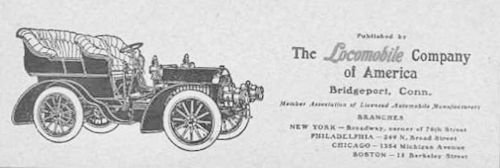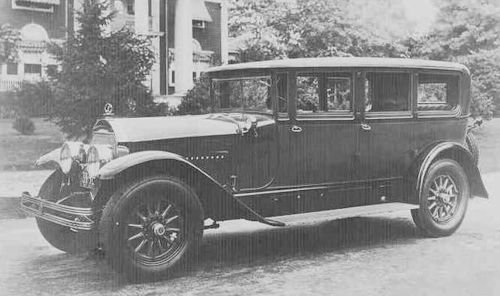Locomobile Company of America
Bridgeport, Connecticut, United States from 1899 to 1922

The Locomobile Company of America was a pioneering American automobile manufacturer founded in 1899. It was one of the earliest car manufacturers in the advent of the automobile age. For the first two years after its founding the company was located in Watertown, Massachusetts. Production was transferred to Bridgeport, Connecticut in 1900, where it remained until the company's demise in 1929. The company manufactured affordable, small steam cars until 1903, when production switched entirely to internal combustion-powered luxury automobiles. Locomobile was taken over in 1922 by Durant Motors and eventually went out of business in 1929. All cars ever produced by the original company were always sold under the brand name Locomobile.
The Locomobile Company of America was founded in 1899, the name coined from 'locomotive' and 'automobile'. John B. Walker, editor and publisher of the Cosmopolitan magazine bought the plans for an early steam-powered vehicle produced by Francis and Freelan Stanley for a price they could not resist: US$250,000 (with all of one car built, but 199 more ordered), promptly selling half to paving contractor Amzi L. Barber. Their partnership lasted just a fortnight; Walker went on to found Mobile Company of America at the Stanley works in Tarrytown, New York, while Barber moved house to Bridgeport, Connecticut, as Locomobile; the Stanley twins were named general managers. The Stanley twins founded the Stanley Motor Carriage Company in 1902, becoming the sharpest rival to Locomobile.
Locomobile began by producing steam cars. The steam Locomobiles were unreliable, finicky to operate, prone to kerosene fires, had small water tanks (getting only 20 mi {32 km} per tank), and took time to raise steam; Rudyard Kipling described one example as a "nickel-plated fraud".Initially, they were offered with a single body style only, an inexpensive runabout at US$600 Nevertheless, they were a curiosity and middle-class Americans clamoured for the latest technology. Salesmen, doctors, and people needing quick mobility found them useful. More than 4000 were built between 1899 and 1902 alone.In 1901, Locomobile offered seven body styles at prices between $600 and $1,400. Most Locomobiles had simple twin-cylinder engines (3x4 in, 76.2x102 mm; 57 in3, 927 cm3) and a wire-wrapped 300-psi boiler, and burned the liquid fuel naphtha to create steam. Typical of the product was the 1904 Runabout, which seated two passengers and sold for $750[5] The two-cylinder steam engine was situated amidships of the wood-framed car. By now, the car had improved boilers and a new water pump, manufactured by the Overman Wheel Company in Chicopee Falls, Massachusetts. This company itself built the Victor Steamer.
During the Boer War, Locomobile did establish a new mark of sorts, becoming the first ever automobile to be used in war; it was a generator and searchlight tractor and catering vehicle, with the useful ability (in British eyes, at least) of being able to brew a cup of tea by tapping the boiler.
This was, unfortunately, not a sure way to guarantee commercial success, even in Britain, and Locomobile started experimenting with gasoline internal combustionengines in 1902, starting with a four-cylinder steel-chassis model designed by Andrew L. Riker. This encouraged the firm to drop steam vehicles the following year, selling the Stanley brothers back their rights for $20,000
Switch to internal combustion engines
The 1904 internal combustion Locomobile Touring Car had a tonneau, space for five passengers, and sold for $4500, quite a change from the low-priced steam buggies. The front-mounted, vertical, water-cooled straight-4 engine produced 16 hp (11.9 kW). A three-speed sliding transmission was fitted, as on the Système Panhard cars with which it competed. The angle steel-framed car weighed 2200 lb (998 kg).
Like other early marques, Locomobile entered motor racing, contesting the 1905 Gordon Bennett Cup with a 17.7-liter (1080 in3) racer; after suffering a transmission gear failure, and with no spare available, driver Joe Tracy only managed two circuits of Auvergne before the transmission packed up entirely. Tracy did better for the company at the Vanderbilt Cup, placing third. A 90-hp (67-kW) 16.2-liter (989-in3) F-head was sabotaged by tire trouble, so Tracy failed again in the 1906 Vanderbilt, but in 1908, George Robertson (wearing #16) took the win in this car, ahead of fellow Locomobile pilot Joe Florida in third, becoming the first United States-built car to win in international competition. This would be the high-water mark for Locomobile racing, and they soon faded from the scene, though Orin Davis did score a win in the Los Angeles–Phoenix rally in 1913.
On the strength of this, Locomobile soon became known for well-built and speedy luxury cars. The 1908 Locomobile 40 Runabout was a 60-hp (44.7-kW) two-seater and sold for $4750. (nearly $100,000 in 2006 dollars)
Model 48 and the Durant years

The most important model for the marque became the impressive Model 48. Introduced in 1919, it had a very conservative, perhaps dated, concept. It had a conventional but huge chassis with a wheelbase of 142 in. Its engine was a straight-six with side valves; cylinders were still cast in pairs and it featured a nonremovable cylinder head. Displacement was 525 in3, giving it a 48.6-hp tax rating by North American Chamber of Commerce. Quality of materials and workmanship were impeccable and among the best in the world. Such was its pricing: A typical open-body cost about $10,000 when the average Model T Ford Phaeton cost about $300.
In 1922, Locomobile was acquired by Durant Motors, which not only continued using the Locomobile brand name for their top-of-the-line autos until 1929, but also still produced the Model 48 until its demise in 1929. Until the mid-1920s, this car was Locomobile's only offering. In 1925, the marque brought out their first new model, the 8-66 Junior Eight, with a more contemporary straight eight-cylinder engine, and more importantly, a lower price of $1,785.
Introduction of the even smaller Junior Six was in 1926, but this car stayed only for one model year. The larger Model 90 that appeared in the same year was produced until 1929.
With the 8-70, Locomobile added one more eight-cylinder car. In the following year, the Junior Eight 8-66 was phased out.
For 1929, a new 8-86 and 8-88 came out, but it was too late to save the company. Locomobile died when its parent company, Durant Motors, failed. Production of the volume cars Durant and Rugby lasted until 1933, but that did not save Locomobile.


